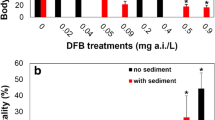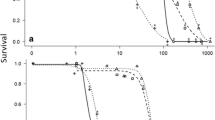Abstract
Esfenvalerate is a neurotoxic pyrethroid insecticide widely used for agricultural and residential purposes and is considered toxic to nontarget organisms such as fish and aquatic invertebrates. In this study, we evaluated the toxicity of esfenvalerate on the aquatic oligochaete Lumbriculus variegatus. In the acute test, organisms showed visible signs of stress but no LC50 value could be determined. In the 28-day chronic test, a significant decrease in reproduction was observed with a NOEC value of 0.25 µg/kg and a LOEC value of 2.34 µg/kg. As for biomass per worm, a significant decrease was also observed with a NOEC value of 2.34 µg/kg and a LOEC value of 36.36 µg/kg. Reproductive impairment and reductions in biomass of L. variegatus exposed to environmentally realistic concentrations of esfenvalerate observed in laboratory tests suggests potential deleterious effects of this pyrethroid on oligochaete natural populations.

Similar content being viewed by others
References
Ǻkerblom N, Arbjörk C, Hedlund M, Goedkoop M (2008) Deltamethrin toxicity to the midge Chironomus riparius Meigen—effects of exposure scenario and sediment quality. Ecotoxicol Environ Saf 70:53–60
Alexander AC, Culp JM, Liber K, Cessna AJ (2007) Effects of insecticide exposure on feeding inhibition in mayflies and oligochaetes. Environ Toxicol Chem 26(8):1726–1732
Amweg EL, Weston DP, Ureda NM (2005) Use and toxicity of pyrethroid pesticides in the Central Valley, CA, USA. Environ Toxicol Chem 24:966–972
ASTM (1980) Standard practice for conducting acute toxicity tests with fishes, macroinvertebrates and amphibians. American Standards for Testing and Materials, Philadelphia
ASTM (2010) Standard test methods for measuring the toxicity of sediment-associated contaminants with fresh water invertebrates (ASTM E1706-00). American Society for Testing and Materials (ASTM), Annual Book of ASTM Standards Volume 11.05, West Conshohocken
Bacey J, Spurlock F, Starner K, Feng H, Hsu J, White J, Tran DM (2005) Residues and toxicity of esfenvalerate and permethrin in water and sediment, in tributaries of the Sacramento and San Joaquin Rivers, California, USA. Bull Environ Contam Toxicol 74:864–871
Bouldin JL, Milam CD, Farris JL, Moore MT, Smith S Jr, Cooper CM (2004) Evaluating toxicity of Asana XL® (esfenvalerate) amendments in agricultural ditch mesocosms. Chemosphere 56:677–683
Brady JA, Wallender WW, Werner I, Fard BM, Zalom FG, Oliver MN, Wilson BW, Mata MM, Henderson JD, Deanovic LA, Upadhaya S (2006) Pesticide runoff from orchard floors in Davis, California, USA: a comparative analysis of diazinon and esfenvalerate. Agric Ecosyst Environ 115(1–4):56–68
Brander SM, Mosser CM, Geist J, Hladik ML, Werner I (2012) Esfenvalerate toxicity to the cladoceran Ceriodaphnia dubia in the presence of green algae, Pseudokirchneriella subcapitata. Ecotoxicology 21:2409–2418
Cánepa A, Basack SB, Casabé NB, Guerrero NRV (2013) Combined effects of technical grade fenitrothion, humic acids and particulate matter on cholinesterase activity in freshwater invertebrates. J Soils Sediments 13:775–782
Capowiez Y, Rault M, Mazzia C, Belzunces L (2003) Earthworm behavior as a biomarker: a study case with imidacloprid. Pedobiologia 47:542–547
Cold A, Forbes VE (2004) Consequences of a short pulse of pesticide exposure for survival and reproduction of Gammarus pulex. Aquat Toxicol 67:287–299
Connon RE, Geist J, Pfeiff J, Loguinov AV, D’Abronzo LS, Wintz H, Vulpe CD, Werner I (2009) Linking mechanistic and behavioral responses to sublethal esfenvalerate exposure in the endangered delta smelt; Hypomesus transpacificus (Fam. Osmeridae). BMC Genomics 10:608
Cooper C, Smith S, Moore M (2003) Surface water, ground water and sediment quality in three oxbow lake watersheds in the Mississippi Delta agricultural region: pesticides. J Ecol Environ Sci 29:171–184
Domagalski JL, Weston DP, Zhang M, Hladik M (2010) Pyrethroid insecticide concentrations and toxicity in streambed sediments and loads in surface waters of the San Joaquin Valley, California, USA. Environ Toxicol Chem 29(4):813–823
Drewes CD (1997) Sublethal effects of environmental toxicants on oligochaete escape reflexes. Am Zool 37:346–353
Egeler P, Gilberg D, Fink G, Duis K (2010) Chronic toxicity of ivermectin to the benthic invertebrates Chironomus riparius and Lumbriculus variegatus. J Soils Sediments 10:368–376
Fairchild J, La Point TW, Schwartz TR (1994) Effects of an herbicide and insecticide mixture in aquatic mesocosms. Arch Environ Contam Toxicol 27:527–533
Floyd EY, Geist JP, Werner I (2008) Acute, sublethal exposure to a pyrethroid insecticide alters behavior, growth, and predation risk in larvae of the fathead minnow (Pimephales promelas). Environ Toxicol Chem 27(8):1780–1787
Forbes VE, Cold A (2005) Effects of the pyrethroid esfenvalerate on life-cycle traits and population dynamics of Chironomus riparius—importance of exposure scenario. Environ Toxicol Chem 24(1):78–86
Galluba S, Oetken M, Oehlmann J (2012) Comprehensive sediment toxicity assessment of Hessian surface waters using Lumbriculus variegatus and Chironomus riparius. J Environ Sci Health A 47:507–521
Kelley K, Starner K (2004) Preliminary results for study 219: monitoring surface waters and sediments of the Salinas and San Joaquin river basins for synthetic pyrethroid pesticides. Department of Pesticide Regulation, Sacramento
Knillmann S, Stampfli NC, Beketov MA, Liess M (2012) Intraspecific competition increases toxicant effects in outdoor pond microcosms. Ecotoxicology 21:1857–1866
Kristoff G, Guerrero NV, D’Angelo AMP, Cochón AC (2006) Inhibition of cholinesterase activity by azinphos-methyl in two freshwater invertebrates: Biomphalaria glabrata and Lumbriculus variegatus. Toxicology 222:185–194
Kristoff G, Guerrero NRV, Cochón AC (2008) Effects of azinphos-methyl exposure on enzymatic and non-enzymatic antioxidant defenses in Biomphalaria glabrata and Lumbriculus variegatus. Chemosphere 72:1333–1339
Kristoff G, Guerrero NRV, Cochón AC (2010) Inhibition of cholinesterases and carboxylesterases of two invertebrate species, Biomphalaria glabrata and Lumbriculus variegatus, by the carbamate pesticide carbaryl. Aquat Toxicol 96:115–123
Leppänen M, Kukkonen JVK (1998) Relationship between reproduction, sediment type and feeding activity of Lumbriculus variegatus (Müller): implications for sediment toxicity testing. Environ Toxicol Chem 17(11):2196–2202
Liu W, Gan JJ, Lee S, Kabashima JN (2004) Phase distribution of synthetic pyrethroids in runoff and stream water. Environ Toxicol Chem 23(1):7–11
Mekebri A, Crane DB, Blondina GJ, Oros DR, Rocca JL (2008) Extraction and analysis methods for the determination of pyrethroid insecticides in surface water, sediments and biological tissues at environmentally relevant concentrations. Bull Environ Contam Toxicol 80:455–460
Mount DR, Highland TL, Mattson VR, Dawson TD, Lott KG, Ingersoll CG (2006) Use of the oligochaete, Lumbriculus variegatus, as a prey organism for toxicant exposure of fish through the diet. Environ Toxicol Chem 25(10):2760–2767
Noskov YA (2011) Comparative sensitivity of the several zooplankton species (Cladocera, Copepoda) to sumicidine-alpha insecticide. Contemp Probl Ecol 4(4):373–378
O’Gara BA, Bohannon VK, Teague MW, Smeaton MB (2004) Copper-induced changes in locomotor behaviors and neuronal physiology of the freshwater oligochaete, Lumbriculus variegatus. Aquat Toxicol 69:51–66
O’Gara BA, Murray PM, Hoyt EM, Logan-Leigh Smeaton MB (2006) The Vitamin E analog Trolox reduces copper toxicity in the annelid Lumbriculus variegatus but is also toxic on its own. Neurotoxicology 27:604–616
OECD (2007) Sediment-water Lumbriculus toxicity test using spiked sediment. Guidelines for the testing of chemicals, no. 225. Organization of Economic Cooperation and Development (OECD), Paris
Phillips BM, Anderson BS, Hunt JW, Huntley SA, Tjeerdema RS, Kapellas N, Worcester K (2006) Solid-phase sediment toxicity identification evaluation in an agricultural stream. Environ Toxicol Chem 25(6):1671–1676
Rasmussen JJ, Wiberg-Larsen P, Kristensen EA, Cedergreen N, Friberg N (2013) Pyrethroid effects on freshwater invertebrates: a meta-analysis of pulse exposures. Environ Pollut 182:479–485
Roman YE, De Schamphelaere KAC, Nguyen LTH, Janssen CR (2007) Chronic toxicity of copper to five benthic invertebrate in laboratory-formulated sediment: sensitivity comparison and preliminary risk assessment. Sci Total Environ 387:128–140
Samsøe-Petersen L, Gustavson K, Madsen T, Mogensen BB, Lassen P, Skjernov K, Christoffersen K, Jørgensen E (2001) Fate and effects of esfenvalerate in agricultural ponds. Environ Toxicol Chem 20(7):1570–1578
Sardo AM, Soares AMVM (2010) Assessment of the effects of the pesticide imidacloprid on the behaviour of the aquatic oligochaete Lumbriculus variegatus. Arch Environ Contam Toxicol 58:648–656
Sardo AM, Soares AMVM, Gerhardt A (2007) Behavior, growth, and reproduction of Lumbriculus Variegatus (Oligochaetae) in different sediment types. Hum Ecol Risk Assess 13:519–526
Schmitt C, Oetken M, Dittberner O, Wagner M, Oehlmann J (2008) Endocrine modulation and toxic effects of two commonly used UV screens on the aquatic invertebrates Potamopyrgus antipodarum and Lumbriculus variegatus. Environ Pollut 152:322–329
Tanner DK, Knuth ML (1996) Effects of esfenvalerate on the reproductive success of the bluegill sunfish, Lepomis macrochirus in littoral enclosures. Arch Environ Contam Toxicol 31:244–251
USEPA (2000) Methods for measuring the toxicity and bioaccumulation of sediment-associated contaminants with freshwater invertebrates. United States Environmental Protection Agency (USEPA), Washington
Weston DP, You J, Lydy MJ (2004) Distribution and toxicity of sediment-associated pesticides in agriculture-dominated water bodies of California’s Central Valley. Environ Sci Technol 38:2752–2759
Weston DP, Zhang M, Lydy MJ (2008) Identifying the cause and source of sediment toxicity in an agriculture-influenced creek. Environ Toxicol Chem 27(4):953–962
Weston DP, Ding Y, Zhang M, Lydy MJ (2013) Identifying the cause of sediment toxicity in agricultural sediments: the role of pyrethroids and nine seldom-measured hydrophobic pesticides. Chemosphere 90:958–964
Wheelock CE, Eder KJ, Werner I, Huanga H, Jones PD, Brammell BJ, Elskus AA, Hammock BD (2005) Individual variability in esterase activity and CYP1A levels in Chinook salmon (Oncorhynchus tshawytscha) exposed to esfenvalerate and chlorpyrifos. Aquat Toxicol 74:172–192
Yang Y, Ma M, Zhou J, Liu J, Liu W (2014) Joint toxicity of permethrin and cypermethrin at sublethal concentrations to the embryo-larval zebrafish. Chemosphere 96:146–154
You J, Brennan A, Lydy MJ (2009) Bioavailability and biotransformation of sediment-associated pyrethroid insecticides in Lumbriculus variegatus. Chemosphere 75:1477–1482
Acknowledgments
This study was supported by COMPETE program (Programa Operacional Fatores de Competitividade, FEDER component) and by National funding through FCT – Fundação para a Ciência e Tecnologia within the research project IDEAL – “Insecticides, DEtritivores and ALiens: Combined effects of invasive species and insecticides along detritus based stream food webs”, Ref: FCOMP-01-0124-FEDER-019380 (Ref. FCT: PTDC/AAC-AMB/119433/2010), FCT and POPH/FSE (Programa Operacional Potencial Humano/Fundo Social Europeu) for the post-doctoral fellowships of J. L. T. Pestana (SFRH/BPD/45342/2008) and M. D. Bordalo (SFRH/BPD/94494/2013).
Author information
Authors and Affiliations
Corresponding author
Rights and permissions
About this article
Cite this article
Rosa, R., Bordalo, M.D., Soares, A.M.V.M. et al. Effects of the Pyrethroid Esfenvalerate on the Oligochaete, Lumbriculus variegatus . Bull Environ Contam Toxicol 96, 438–442 (2016). https://doi.org/10.1007/s00128-015-1718-y
Received:
Accepted:
Published:
Issue Date:
DOI: https://doi.org/10.1007/s00128-015-1718-y




